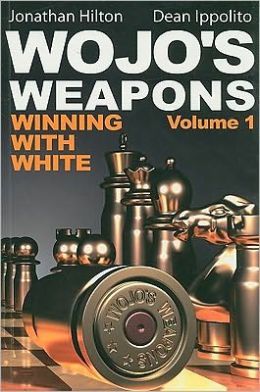Wojos Weapons 1
Winning With White
Dean Ippolito, Jonathan Hilton

The late Alexander Wojtkiewicz was a complicated and tragic figure. A product of the Latvian chess school that produced such talents as Shirov, Shabalov and Kengis, the teenage Wojtkiewicz served as one of Mikhail Tals seconds during the 1979 Interzonal where he impressed a young Yasser Seirawan as a great talent.
Regrettably this ability only emerged on the international stage after Wojtkiewicz had left for his fathers native Poland after a stint in jail in the Soviet Union for avoiding military service. During the second half of the 1980s and early 1990s Wojt or Wojo, as he was often called, played board one for Poland in the Olympiads and European Team Championships but he eventually grew tired of the place/out grew his welcome. Though blessed with good looks and extremely intelligent, Wojo had a self-destructive side that compelled him to chain smoke and worship Dionysus to excess. Not for nothing was he sometimes referred to as Vodkavich. Wojt was usually very charming but when he was in his darkest moods he was to be avoided.
By the mid 1990s Wojtkiewicz was spending more and more time in the United States and when he landed a chess scholarship at the University of Baltimore at Maryland County, he had made a complete transition from the Old to the New World. Competing in the U.S. meant playing almost exclusively in Swiss events, often two or three games a day over a single weekend. This format required a practical and economic style that would grind out wins without expending unnecessary energy.
This way of playing came naturally to Wojo who, although a great lover of chess, was not a systematic studier. He clearly appreciated the fact that playing in short Swisses minimized pre-game preparation and thrived in his new environment, winning the U.S. Grand Prix six years in a row from 1999 to 2004. During the last eight years of his life he won or tied for first in a staggering 240 tournaments.
One of Wojts weapons in amassing this incredible repertoire was his skill at opening 1.Nf3, often steering the game into 1.d4 openings by transposition. It is this repertoire that is extensively examined in Wojos Weapons: Winning With White, Volume 1 by Jonathan Hilton and Dean Ippolito.
Volume one of this series deals with the sequence 1.Nf3 d5 2.d4, with the largest part of the book devoted to the Catalan but with lengthy sections on the Slav and the Tarrasch, which breaks down as follows:
* Part I: The Closed Catalan (1 page)
* An Introduction to the Close Catalan (35 pages)
* The Closed Catalan with 4…
Bb4+ (23 pages)
* Assembling the Repertoire (7 pages)
* Part II: The Open Catalan (1 page)
* The Delayed Open Catalan with 7.Ne5!? Nc6 (32 pages)
* The Delayed Open Catalan with 7.Ne5!? c5 (and others) (11 pages)
* The Early Open Catalan with 5
…Nc6 (41 pages)
* The Early Open Catalan with 5
…c5 (23 pages)
* The Early Open Catalan with 5
…a6 6.Ne5 Bb4+ (8 pages)
* The Early Open Catalan with 5
…a6 6.Ne5 c5 (27 pages)
* The Early Open Catalan with 5
…b5 or 5…
c6 (11 pages)
* The Early Open Catalan Others (5…
Bb4+, 5
…Nbd7, 5
…Bd7) (22 pages)
* Part III: The Slav Defense (1 page)
* The Slav Defense with 4.Qc2 dxc4 (27 pages)
* The Slav Defense with 4.Qc2 g6 (16 pages)
* Semi-Slav Hybrids with 1.Nf3 d5 2.d4 c6 (8 pages)
* Part IV: Black’s Other Defenses (1 page)
* The Queen’s Gambit Accepted (26 pages)
* The Tarrasch (28 pages)
* Systems with 2…
Bf5 (13 pages)
* The Chigorin (14 pages)
* The Austrian Defense (9 pages)
If this repertoire rings a bell it should. Israeli GM Boris Avrukh also advocated the Catalan in his mammoth book 1.d4 Volume 1 (Quality Chess, 2008) but via 1.d4. While both books like the Catalan for White they differ a fair amount in the individual lines they recommend. For example, after 1.Nf3 d5 2.d4 Nf6 3.c4 e6 4.g3 dxc4 5.Bg2 c5 6.0-0 Nc6 Avrukh favored the sharper 7.Qa4 while Ippolito and Hilton prefer 7.dxc5. Likewise after 1.Nf3 d5 2.d4 Nf6 3.c4 e6 4.g3 Bb4+ 5.Bd2 Be7 6.Bg2 0-0 7.0-0 c6 8.Qc2 Nbd7 Hilton and Ippolito like 9.Bf4 getting double duty as it also provides an answer to the Closed Catalan proper 1.Nf3 d5 2.d4 Nf6 3.c4 e6 4.g3 Be7 5.Bg2 0-0 6.0-0 c6 7.Qc2 Nbd7 8.Bf4. Avrukh, who is more of a maximalist striving for the biggest possible advantage than a pragmatist, gives different lines against …Bb4+-e7 and …Be7.
This pragmatism is one of the differences between the two books, while another is that in general Wojt didnt always play the most critical lines, being confident in his excellent technique to realize a small advantage. This ability is often mentioned in Wojos Weapons: Winning With White, which is very well-written and spends a lot of time explaining what White is trying to accomplish. There is plenty of theory and important theoretical novelties in this book but at the end of the day most users will find the carefully and heavily annotated games to be its biggest strength.
Wojos Weapons: Winning With White is recommended for players 2000 on up that are looking for a solid and reliable opening repertoire. Ippolito and Hilton have made a successful debut that would have pleased their hero.
